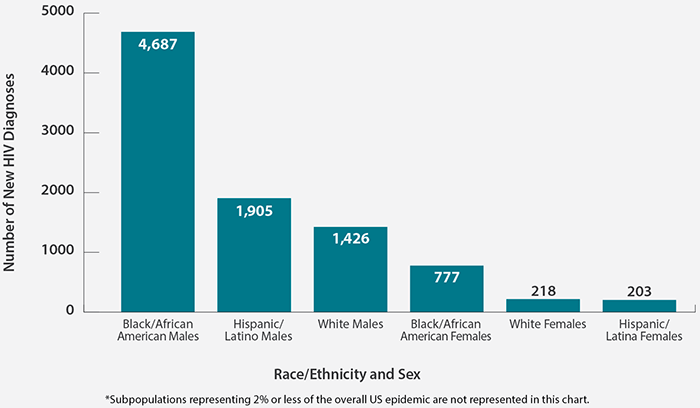HIV Among Youth in The United States
In April, many youth-oriented organizations are observing National Youth HIV & AIDS Awareness Day (NYHAAD) and National Transgender HIV Testing Day. Youth in the U.S. have never known a world without HIV. One in five HIV infections occurs in people ages 13-24.
In 2014, youth aged 13 to 24 accounted for an estimated 22% of all new HIV diagnoses in the United States. Most of those occurred among young gay and bisexual males. Young black/African American and Hispanic/Latino gay and bisexual males are especially affected. Youth with HIV are the least likely out of any age group to be linked to care. Addressing HIV in youth requires that we give youth the tools they need to reduce their risk, make healthy decisions, get treatment and care if needed, and communicate effectively with others.

The Numbers
HIV and AIDS Diagnoses
- An estimated 9,731 youth aged 13 to 24 were diagnosed with HIV in 2014 in the United States. Eighty-one percent (7,868) of diagnoses among youth occurred in persons aged 20 to 24.
- Among youth aged 13 to 24 diagnosed with HIV in 2014, 80% (7,828) were gay and bisexual males. Of those newly diagnosed young gay and bisexual males, 55% (4,321) were black, 23% (1,786) were Hispanic/Latino, and 16% (1,291) were white.
- From 2005 to 2014, HIV diagnoses among both black and Hispanic/Latino gay and bisexual men aged 13 to 24 increased about 87%. Among young white gay and bisexual men, HIV diagnoses increased 56%. However, the most recent 5 years of data (2010-2014) indicate that the diagnoses among black and white gay and bisexual men aged 13 to 24 have stabilized and the increase has slowed to 16% among Hispanic/Latinos.
- In 2014, an estimated 1,716 youth aged 13 to 24 were diagnosed with AIDS, representing 8% of total AIDS diagnoses that year.

Estimated New HIV Diagnoses Among Youth Aged 13-24 in the United States, by Race/Ethnicity and Sex, 2014. Source: CDC
Living With HIV and Deaths
- At the end of 2012, an estimated 57,200 youth aged 18 to 24 were living with HIV in the United States. Of these, 25,300 were living with undiagnosed HIV—the highest rate of undiagnosed HIV in any age group.
- Among youth aged 13 to 24 who were diagnosed with HIV in 2013, 78% were linked to care within 3 months—the lowest rate of any age group.
- Among youth diagnosed with HIV in 2011 or earlier, 52% were retained in HIV care at the end of 2012.
- Among youth aged 18 to 24 who were living with HIV in 2012, 21% were prescribed HIV medicines (antiretroviral therapy or ART), and 16% had a suppressed viral load—the lowest rates of any age group.
- In 2013, 109 youth aged 15 to 24 died of HIV or AIDS.
Prevention Challenges
Inadequate Sex Education. The status of sexual health education varies substantially throughout the United States and is insufficient in many areas according to CDC’s 2014 School Health Profiles. In most states, fewer than half of high schools teach all 16 critical topics that CDC recommends for inclusion in curriculums. Specifically, many curricula do not include prevention information that relates to the needs of young gay and bisexual men. In addition, sex education is not starting early enough: in no state did more than half of middle schools meet goals put forth by CDC. Finally, sex education has been declining over time across the country. The percentage of US schools in which students are required to receive instruction on HIV prevention decreased from 64% in 2000 to 41% in 2014.
2013 data from the Youth Risk Behavior Surveillance System (YRBS), which monitors health risk behaviors that contribute to the leading causes of death and disability among youth reveal:
- Low rates of testing. Only 22% of high school students who had ever had sexual intercourse had been tested for HIV.
- Low rates of condom use. Of the 34% of high school students reporting sexual intercourse during the previous 3 months, 41% did not use a condom the last time they had sexual intercourse.
- Substance use. Among the 34% of currently sexually active students nationwide, 22% had drunk alcohol or used drugs before their most recent sexual intercourse.
High rates of sexually transmitted diseases (STDs). Some of the highest STD rates are among youth aged 20 to 24, especially youth of color. The presence of another STD greatly increases a person’s likelihood of getting or transmitting HIV.
Stigma around HIV. In a 2012 Kaiser Family Foundation survey, 84% of youth aged 15 to 24 said there is stigma around HIV in the United States, which means they may not be comfortable discussing their status with others and agreeing on measures to protect themselves and their partners. For gay and bisexual youth who are just beginning to explore their sexuality, homophobia can pose obstacles to HIV testing and treatment.
Feelings of isolation. Gay and bisexual high school students may engage in risky sexual behaviors and substance abuse because they feel isolated and lack support. They are more likely to experience bullying and other forms of violence, which can lead to mental distress and engagement in risk behaviors that are associated with getting HIV.
How to Participate
- Promote NYHAAD by tweeting @youthaidsday and using the hashtags #NYHAAD and #NYHAAD17.
To learn more, visit the Centers for Disease Control and Prevention page
Buzz
- 11/04/2022 Latino Impact Summit - TDN President/Founder Ariel Rojas attended this event at the United Nations... read more>>
- 10/27/2022 Latin Grammy Awards - TDN Artistic Ambassador Glenda del Monte Escalante is a nominee for the next edition of the Latin Grammys... read more>>
- 10/24/2022 Heritage Celebration - TDN President/Founder Ariel Rojas attend community event Quisqueya: A Celebration of Haitian and Dominican Heritage... read more>>
- 10/21/2022 TDN / UN Women - TDN President/Founder Ariel Rojas and TDN Youth Ambassador Alicia Rando meet with UN Women representative... read more>>
- 09/09/2022 Book of Condolence - Because of Queen Elizabeth's death, TDN President/Founder Ariel Rojas signs book of condolence... read more>>
